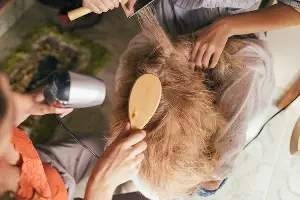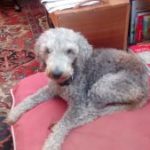
As loving parents, we take our dogs to be groomed in order to keep them comfortable and healthy.
And these treatments aren’t cheap.
So when they come back from these sessions and they clearly aren’t comfortable, it can be a bit of a shock.
One of these behaviours is scooting.
In this article, I will explain why dogs scoot after grooming sessions and some steps to take when it happens.
So why is your dog scooting after a grooming session? Let’s examine some of the possible reasons for this.
Three Main Reasons That Dogs Might Scoot After Grooming?
There are many reasons why a dog may scoot after grooming. Here are some of the most common:
Razor Burn
Razor burn is a term often used in grooming circles and refers to irritation in the skin’s top layer caused by clippers.
Razor burn is a common grooming injury. In most cases, this type of burn causes only minor distress in dogs; however, some animals may be distressed.
When you realize such issues with your dog, it is recommended that you talk to a vet especially if your has been in a grooming session recently.
Irritation of Glands Under the Tail
A dog who scoots after being groomed may do so because the groomer has pressed the glands under its tail. Dogs have special glands around their bum, and when these are squeezed, it can cause discomfort, leading to this scooting.
Coarse Hairs Causing Friction
If your dog’s hair is coarse or curly, it can cause friction against the skin and lead to itching especially when it gets tangled around the anal glands. It also causes friction in the anal area.
Hair around the anus can be very irritating to your dog, especially if they have sensitive skin or allergies. The irritation causes them to scoot their bottom along the ground, trying to relieve themselves by rubbing against it.
Your dog may also lick their bottom excessively or scratch at it with its paws if they develop an infection from having coarse hairs around its anus.
Six Quick Fixes That the Owner Can Do to Stop the Scooting?
When your dog is scooting it clearly shows it is uncomfortable and that means you should do something to help it. Here are some actions to take to help your dog.
Apply Fish Oil to the Swollen Anal Gland
If your dog has an anal gland infection, you should apply a few drops of fish oil to the swollen gland. This will help reduce inflammation and improve their condition. It is best to do this twice daily until symptoms subside.
Give Anti-Inflammatory Treatments
An anti-inflammatory treatment can help reduce the swelling and pain associated with scooting. These treatments include ibuprofen, aspirin, or other NSAIDs (nonsteroidal anti-inflammatory drugs). Anti-inflammatories are best given 1-3 days before and after the grooming appointment, but they can also be given during the appointment if needed for immediate relief.
Increase Fiber
Feed your dog foods that contain more fiber. Give them fibrous snacks like pumpkin, carrots, or apples. Or add a fiber-filled supplement to the food you’re already giving them.
Adding fiber to your dog’s diet will make their stools larger and more frequent, which empties the anal sacs faster. Adding canned pumpkin or pureed cooked sweet potato or carrots is an excellent way to increase fiber in your dog’s diet.
Probiotic-Rich Food for Your Dog’s Diet
Probiotics are good for digestive health and can help balance the bacterial flora in your dog’s gut. Add yogurt or other fermented foods to your dog’s diet and watch for improvements in his poop!
If your dog has had worms, consider adding a probiotic supplement to its meals while it is recovering from those conditions.
More Water
Many times dogs will scoot simply because they’re dehydrated. Increased water intake can help keep your dog hydrated hence reducing scooting. Dogs should be encouraged to drink more water and eat moisture-rich foods to reduce anal gland problems.
More Exercise
If you add a session of exercise to your Dog’s daily routine and encourage playtime as well, both activities will help empty the anal glands.
Five Other Behaviors That a Dog Might “Show” To Indicate That They Are Uncomfortable After a Grooming Session?
Your dog might show some other signs to indicate its discomfort after grooming other than scooting. These may include
Changes in Behavior
If your dog is not regularly groomed, it might act differently after the grooming session. Some dogs may become anxious or even aggressive toward other dogs or people. This is especially true if they were not relaxed during the grooming process or if they were uncomfortable with having their nails clipped by the nail trimmer.
Restlessness and Pacing Around the House
If your dog seems restless or keeps pacing around the house after being groomed, it could be due to stress from the experience, especially if you saw any signs of discomfort during the grooming session.
Vomiting
If your dog vomits after its grooming, contact your veterinarian right away. It may have eaten something that didn’t agree with it or be experiencing an allergic reaction to the shampoo used during the grooming session.
Signs of Aggression
Grooming can be a scary time for your dog. The smells, sounds, and movements of the groomer can be overwhelming. It’s possible that aggressive behavior may stem from fear or anxiety related to being groomed.
Dogs can sometimes feel uncomfortable around strangers, which can continue even after the grooming session, it usually doesn’t last for long, but it’s worth noting if it stays for long.
Itching
It could result from an allergic reaction to the shampoo, conditioner, or other grooming products when you realize that your dog is itching after the grooming session. It could also be caused by a skin infection or an insect sting. Ensure that you take your dog to the VET if the itching persists for a long.
Five Main Reasons That Dogs Scoot Other Than grooming?
You might realize that your dog is scooting but it has not been in a grooming session, this may be caused by a number of issues including:
General Itching
This can be due to fleas or other parasites, allergies, and even contact dermatitis. Some dogs will scoot on one side more than the other, which could indicate an infection in that area.
If your dog is scooting, checking for parasites first is essential. Fleas can be treated with flea collars, sprays, and dips. If your dog has allergies, there are many treatments available, including special diets, medications, and daily allergy shots.
If you’re not sure if your pet has general itching or another problem such as allergies, it’s best to consult a veterinarian.
Food Allergies
Dogs with digestive problems caused by food allergies or intolerances may develop anal gland issues. If your dog vomits, pay attention to other gastrointestinal signs like diarrhea and contact the vet if you suspect they’ve ingested a substance they can’t digest.
Skin Allergies
Skin allergies in dogs can cause itching and scratching. You can research the different types of dog allergies and the steps to take when you notice such issues.
Neurological Causes
Dogs may also manifest unusual behavior as a sign of cognitive decline or other neurological problems. If your older dog starts dragging its bum on the floor and you notice increased restlessness and vocalization, you should discuss these things with the vet.
Matted Hair
The matted hair around a dog’s bottom can cause itching and irritation, leading to excessive scooting. Such issues can easily be solved by regular grooming of your dog.
When to See the Vet
If a dog has scooted only once or twice in the last few days. But if it’s been doing it repeatedly or for more than three days, get it checked out by your vet.
The vet will first examine your pet’s anus and anal glands to identify any problems with inflammation or infection.
They may also want to perform a fecal test, which examines whether parasites are present within their intestines. If your dog’s fecal test comes back positive for any parasites, your vet will prescribe a deworming medication to eliminate the worms and stop his scooting.
If a dog’s anal glands are full or look impacted, the vet will attempt to express them. If they’re affected, it might not be possible for the vet to do this; therefore, medication may need to be put into his system to clear them out.
If the problem is chronic, surgery to remove a dog’s anal glands can be complex. Most vets will refer you to an animal hospital for this procedure.
Conclusion
The dogs anal glands are very sensitive and prone to infections too, when it is affected, the main sign is scooting in dogs, this may be evident after grooming or when there has been an infection.
The main causes of scooting in dogs after grooming razor burns, irritation of glands under the tail and and a course hair under the tail. This can be distressful to both you and your dog.
If you think your dog might have fleas, then you can give you dog anti-parasitic medications to remedy the condition. However, if your dog is suffering from an anal gland issue, then you can visit the vet to help the dog.
Photo credits
¹ Photo by J. Balla Photography on Unsplash





